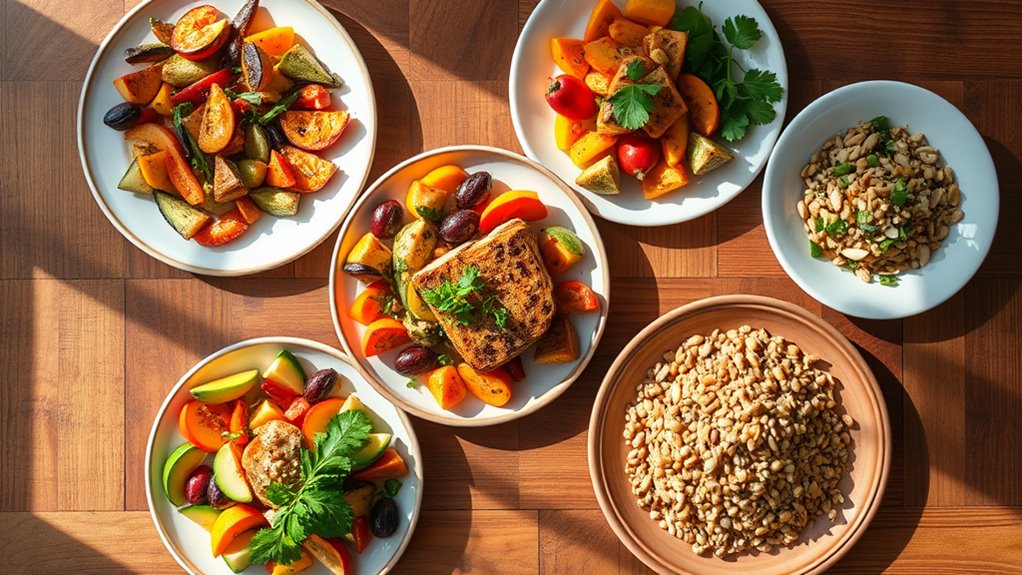5 Balanced Plate Tricks That Make Healthy Eating a Breeze
Eating healthy doesn’t have to feel like a chore. By adopting a few simple strategies, you can make nutritious choices feel second nature. For instance, filling half your plate with fruits and veggies isn’t just a good idea; it’s an easy way to boost your intake of essential nutrients. Curious about how to keep your meals satisfying and vibrant without a lot of effort? Let’s explore five practical tricks that can transform your approach to healthy eating.
Embrace the Half-Plate Rule
Have you ever wondered how to create a balanced meal without overthinking it? Embrace the Half-Plate Rule.
Fill half your plate with vegetables and fruits, which provide essential vitamins, minerals, and fiber.
The other half should be divided between lean proteins and whole grains.
This simple approach ensures you’re getting balanced meals while making mealtime decisions easier. Research shows that this method promotes healthier eating habits and weight management. Additionally, incorporating simple tricks can enhance your meal planning and encourage variety in your diet.
Color Your Plate With Variety
How can you make your meals not just nutritious but visually appealing?
Adding a variety of colors to your plate can enhance both the look and health benefits of your meals.
Colorful fruits and vegetables often contain different vitamins and minerals, making your meals more nutritious. One easy way to increase your vegetable intake is by incorporating more vegetables into your favorite dishes, like adding spinach to pasta or blending carrots into smoothies.
Try incorporating:
-
Spinach or kale for greens
-
Carrots or bell peppers for orange
-
Blueberries or purple cabbage for blue/purple
-
Cauliflower or onions for white
-
Tomatoes or strawberries for red
Include Protein in Every Meal
What’s the secret to a balanced meal? Including protein in every meal boosts satiety and helps maintain muscle mass.
Aim for lean meats, fish, eggs, beans, or dairy to round out your plate. Studies show that protein stabilizes blood sugar levels, keeping you energized throughout the day. In fact, including eggs and cholesterol in your diet can provide essential nutrients while keeping your cholesterol levels in check.
It’s simple: add grilled chicken to your salad, toss beans into your stir-fry, or blend Greek yogurt into your smoothie. Not only does protein make meals more satisfying, but it also aids in recovery and overall health.
Choose Whole Grains Over Refined
Elevate your meals by choosing whole grains over refined options.
Whole grains are packed with nutrients and fiber, helping you feel fuller longer while supporting digestive health. Additionally, carbohydrates can be beneficial when sourced from whole grains rather than refined products, as they provide sustained energy and essential nutrients.
Here are some easy swaps:
-
Brown rice instead of white rice
-
Whole wheat bread in place of white bread
-
Quinoa instead of couscous
-
Oats instead of sugary cereal
-
Barley for a hearty soup base
Making these choices not only boosts your energy levels but also reduces the risk of chronic diseases.
Start incorporating whole grains into your diet today for a delicious and nutritious upgrade!
Don’t Forget Your Healthy Fats
Have you considered the role of healthy fats in your diet?
Incorporating sources like avocados, nuts, seeds, and olive oil can enhance your meals while providing essential nutrients.
Healthy fats support brain function, reduce inflammation, and help absorb vitamins A, D, E, and K.
Healthy fats are essential for brain function, inflammation reduction, and the absorption of crucial vitamins A, D, E, and K.
Aim to fill about 20-35% of your daily calorie intake with these fats.
By replacing saturated fats with healthier options, you’ll not only enjoy better heart health but also feel fuller longer.
So, don’t shy away from adding a drizzle of olive oil to your salad or a handful of nuts as a snack.
Your body will thank you!
Additionally, it’s important to understand that low-fat diets may not always provide the health benefits that many assume.




